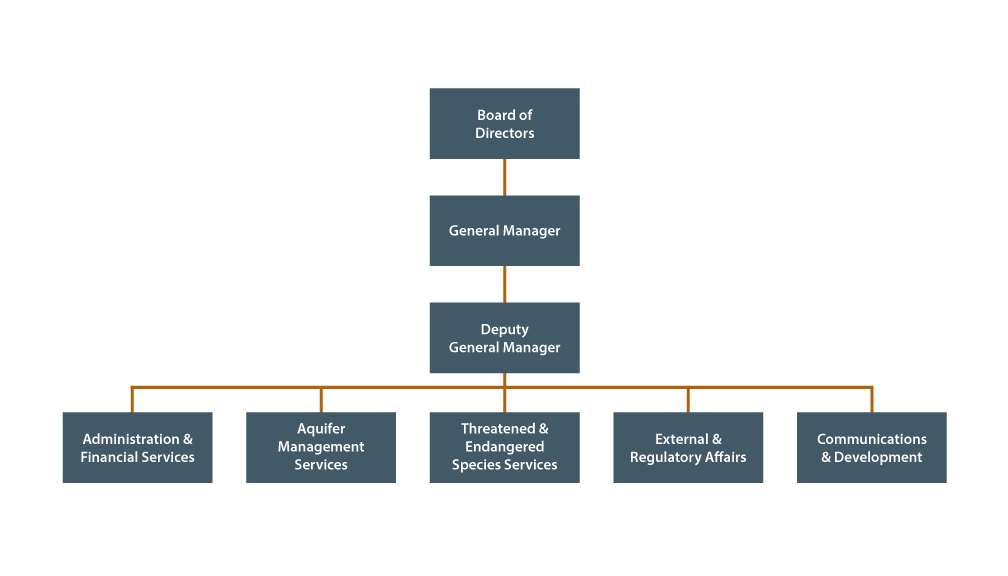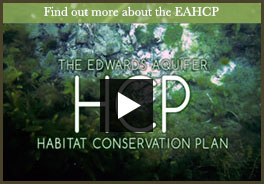EAA Departments
Organizational Structure

Board of Directors
Determines EAA policies and hires the General Manager to manage all EAA operations.
Executive Office
Consists of the General Manager, Deputy General Manager, and the Executive Assistant who manage all organizational operations and oversee the activities of the EAA’s outside counsel.
Administration & Financial Services
Provides all organizational support activities with supplies, equipment, facilities and technology available; meets the EAA’s financial, technological, and human resource needs to keep the organization operating efficiently
Financial Services – Conducts all activities associated with payroll, accounts payable, accounts receivable, budget, audits, investment activities, property, casualty, and workers’ compensation insurance; promotes fair and effective purchasing for the entire organization—staff strives to award at least 30% of its contracts to minority-owned or woman-owned businesses.
Human Resources – Administers all employee and staffing related activities, including employment processing, employee benefits administration, compensation, safety training, staff development; manages the EAA’s administrative support and college internship program.
Information Technology – Ensures EAA staff has high quality and dependable computer technology available to accomplish its mission; works with all teams using efficient technologies that support their mission.
Records – Ensures maintenance of all records; ensure proper filing, archival, retrieval and destruction of EAA files; responds to public information requests.
Operations – Supports the entire organization, by overseeing building improvements, facility maintenance, vehicle maintenance, office equipment purchases and leases, and utilities.
Aquifer Management Services
Responsible for data collection, research, modeling, sampling, monitoring, well-registration and other technical matters related to the aquifer; maintains active and historical water data across the region; performs research to better understand the aquifer system and makes refinements to the conceptual model of the aquifer; monitors spills and development activities over the recharge zone, develops and maintains well registrations, and well construction permits and analyzes risks of abandoned wells.
Aquifer Science Research – Research projects are conducted to address questions directly related to the understanding and management of the Edwards Aquifer. Information collected through the program is used to expand our understanding of the aquifer and refine the conceptual model of the aquifer system; collects water quality data, stream flow data, and water level data.
Aquifer Protection – Reviews plans for development on the recharge zone, monitors EAA-owned conservation easements, assists other entities with conservation easement acquisitions and monitoring, and conducts educational activities related to aquifer protection.
Modeling & Data Management – Conducts groundwater modeling using computer models developed specifically for the Edwards Aquifer and that are periodically refined through ongoing research related to the aquifer system; properly collects, stores, analyzes, checks, and retrieves the multiple data streams that are the EAA’s responsibility.
Remote Gauging – Uses data collected from a real-time network of rain gauges located across the region to assist in recharge calculation, production of rainfall maps, and in a variety of research projects by the EAA and other stakeholders.
Recharge Enhancement Program – Continues to refine groundwater and hydrological models to better represent local conditions prior to pursuing any new EAA-funded recharge project; oversees the precipitation enhancement (cloud seeding) program to increase recharge and reduce irrigation demand.
Range Management – Provides cost share incentives to landowners who perform brush control on properties located on the Edwards Aquifer Recharge Zone with the goal of improving water quality and recharge potential to benefit all aquifer users; develops agreements with landowners to formalize brush control and landowner reimbursement details, develops program information documents, inspects properties, and administers reimbursement payments.
Groundwater Protection – Registers Edwards Aquifer wells within the EAA’s jurisdiction; identifies risk assessment of abandon wells and appropriate remedies for them; administers permits for wells drilled into or through the Edwards Aquifer; responsible for maintenance of EAA operated recharge structures.
Karst Initiatives – Provides expertise to stakeholders of the unique vulnerabilities associated with karst landscapes and groundwater associated with karst aquifers; works to enhance water quality protection measures through first responder education, professional lecture series, and exploration of innovative technologies; evaluates karst features, and determines geological properties.
Threatened & Endangered Species Services
The Threatened & Endangered Species Department manages the Edwards Aquifer Habitat Conservation Plan (EAHCP) which defines how we protect federally listed species that live in the Edwards Aquifer and the Comal and San Marcos springs. Our program’s Incidental Take Permit was granted to the Edwards Aquifer Authority, City of San Marcos, City of New Braunfels, Texas State University, and the City of San Antonio acting by and through the San Antonio Water System (collectively known as the EAHCP Permittees) to protect federally listed species from specific activities. The EAHCP implements the following measures to protect the Covered Species and their habitat:
Habitat Protection Measures – Performs minimization, mitigation and monitoring measures in the Comal and San Marcos spring systems, including (but not limited to) native aquatic habitat restoration, riparian habitat restoration, impervious cover/water quality protection, litter collection, floating vegetation management, non-native animal species control, and management of household hazardous wastes.
Flow Protection Measures – Helps protect and maintain springflow in the Comal and San Marcos spring systems by implementing the Regional Water Conservation Program, Voluntary Irrigation Suspension Program Option, Stage V Critical period and the SAWS-Aquifer Storage and Recovery program.
Supporting Measures – Implements and supports applied research, biological monitoring, expanded water quality monitoring, and refugia centers.
External & Regulatory Affairs
Administers and enforces the EAA’s rules; manages production from the aquifer through a comprehensive permitting, metering, and drought management system; serves as a resource to the regulated community and area stakeholders; and effectively communicates with all levels of government.
Elections – Holds elections for director positions on the general election day in November of every even-numbered year. EAA directors serve staggered four-year terms.
Intergovernmental Relations – Communicates with the legislature and other political and governmental entities, including, but not limited to various committees of the House and Senate, such as the Edwards Aquifer Legislative Oversight Committee, regional water planning groups, groundwater management areas, and other water-related regulatory or planning entities.
Meters – Manages a network of EAA-installed meters on approximately 600 irrigation wells and maintains records for approximately 1,000 industrial and municipal wells; checks and reads every meter at least once a year; gathers and maintains data related to meter registration and groundwater use reporting; manages the EAA’s Remote Meter and Meter Accuracy Verification programs.
Regulatory Affairs & Water Resources – Administers several regulatory programs related to groundwater production and protection, including regulating the metering and reporting of groundwater withdrawals, the storage of regulated materials, aboveground and underground storage tanks, and the overall, general enforcement of all EAA rules; and helps administer the Edwards Aquifer Habitat Conservation Plan Aquifer Storage and Recharge Program.
Communications & Development
Takes an intentional and strategic approach to communication across all EAA operations to enhance greater cohesion, collaboration, and consistency in public information dissemination; responsible for the administration of the Edwards Aquifer Conservancy (EAC), including planning and execution of activities focused on building awareness and financial support of the EAA and its mission.
Community Initiatives & Media Relations – Builds public understanding of the EAA’s mission and programs through informational campaigns, speakers’ bureaus, media relations, social media efforts, and community outreach efforts throughout the region; develops and provides as needed support materials relating to program-specific information with permit holders, stakeholders, and other interested parties.
STEM/School Education – works with students and teachers in the region to educate them on water-related issues, specifically as they relate to the Edwards Aquifer.
Creative Services – Develops and executes marketing materials that sustain the EAA brand; consistently and clearly communicates the EAA’s marketing objectives by fostering and maintaining brand identity.
Web & Digital Media – Manages website, digital applications, and supporting services; ensures each is up-to-date with the latest features, functions and content; identifies and implements strategic initiatives, keeping all digital content accurate, timely, and relevant.
Edwards Aquifer Conservancy – Solely supports and benefits the work of the EAA, including the establishment of programs and practices that protect habitat and species, sustain agricultural practices, promote water conservation, and support the development of water management solutions within the diverse Edwards Aquifer region.
